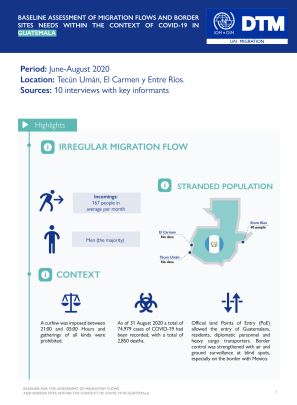-
Countries
-
Data and Analysis
-
Special Focus
-
Crisis Responses
Guatemala-Baseline assessment of migration flows and border sites needs within the context of COVID-19 report- #1 (June-August, 2020)

Contacter
Walter Arreaga warreaga@iom.int
Langue
English
Emplacement
Guatemala
Période couverte
Jun 01 2020
Aug 31 2020
Activité
- Mobility Tracking
- Baseline Assessment
- Event Tracking
Due to the alarming levels of propagation and the serious nature of the COVID-19 virus, on 11 March 2020 the OMS declared a State of Pandemic. The Guatemalan government had already declared a State of Calamity and Red Alert on 05 March 2020, due to the detection of the first case in Central America. The first case of COVID-19 in Guatemala was detected on 13 March 2020, with the first death recorded in the country on 15 March.
In order to prevent COVID-19 contagions, Guatemala has established various guidelines in response to the Pandemic. In terms of border control, the borders were closed and official land Points of Entry (PoE) allowed the entry of Guatemalans, residents, diplomatic personnel and heavy cargo transporters; they remain under partial operation. However, exit from Guatemalan territory is permitted for any person.
In addition, a series of restrictions have been established as part of the control to mitigate the spread of COVID-19 in the entry of persons to Guatemala. The measures adopted in border control focus on restricting entry by nationality, restricting entry to Guatemala in its entirety, and complying with measures of home isolation, quarantine on entry to the country, and other relevant medical checks.
In light of the situation caused by the COVID-19 Pandemic, the IOM seeks to determine: the impact of same on mobility in regular and irregular migratory flows; the needs of migrants; and the measures taken to prevent propagation of the virus along the borders of Guatemala. This is the reason this Study was carried out, in order to generate baselines for comprehending existing needs at the official and unofficial points of entry, in order to provide input to orient actions to be taken by protection organizations at the inter-agency level, local governments, cross-border panels, and IOM field personnel.
